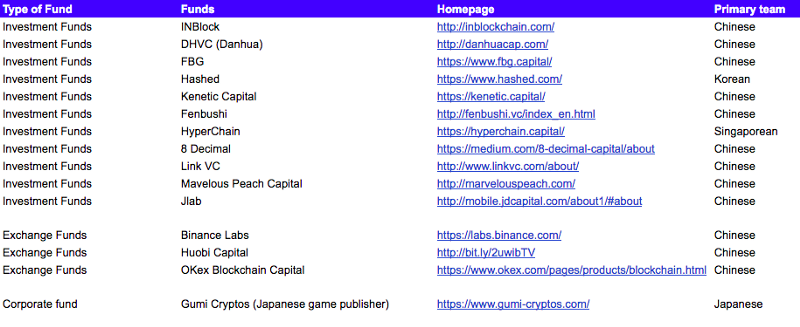Quick Guide to Raising Money in North America with China/Asia Investors

Hope Liu, CEO, and co-founder, of EximChain and Ryan Fang, co-founder and COO of Ankr.Network are two Chinese-born co-founders with deep knowledge of regulations, fundraising and hiring in China. After our discussion on the Global Coin podcast, I realized that knowledge about Asia funds may be quite limited in English-speaking countries. So here I take our discussion from the podcast and give you a brief, initial guide on how to raise money from China/Asia fund and some go to market strategy tips there.
1. Wait, but why?
Even though we focused specifically on Chinese investors in our latest podcast, I’ve come to believe that raising money from investors who are not local to where your team is based is CRUCIAL to one’s success as a Crypto company. Not only can the overseas investors bring a vastly different point of view to the table (and there are a lot of sharp investors overseas), but they can also provide you access and market opportunities in the other half of the hemisphere that otherwise would have been difficult. Ryan, in the podcast, recommends a balance of Eastern and Western profile investors in one’s investor base. And Hope stresses that you should think deeply about who your target audience and users are before you decide on the type of investors to raise from.
2. Now, who should I raise from?
To tap the Eastern markets, I think there are two types of funds you can raise from. First, you can find strong US investors with a China-focused partner, team or have existing relationships in Asia. In the US funds that I saw, I’ve found geographically most are focused on China, so if you know of funds with Japan/Korea/ Singapore focuses please let me know. The alternative, and the increasingly more popular way, is to find Chinese/Asia investors with heavy US involvement. I’ve identified the top funds of both aforementioned categories in the spreadsheet here. Please let us know should we missed any.

3. How do you pitch to these China/Asia based funds?
In the current fundraising environment, more often the English-speaking investors are focused on what you can deliver technically, and what advanced technology, tokenonomics or consensus model are you adopting. In the Chinese investing community, investors may or may not fully understand the technology (depending on whether they have technical members on the team), but they will be focusing on your go-to-market adoption and your product. They will care about how you’ll convince businesses to pay and adopt your product. Hope mentioned an anecdote of when she was sending out 500 cold emails pitching to investors on EximChain’s unique Quadratic Voting governance model, but realized that she should have been pitching the type of results Eximchain would deliver, types of problems the company is planning to solve and the plan and timeline to get the technology adopted.
Ryan says that compared to their American counterparts, many Chinese investors care more about price, such as how much the tokens would be able to sell in the secondary market, and what is the upside from pre-sale prices. Frankly, I think that every investor is and should be thinking about upside and risk management in this volatile space. To me, it seems that the Chinese investors are more direct about asking and talking about prices, exit strategy and token upside than their American counterparts. This could potentially be a good opportunity for every entrepreneur/founder to prepare their thoughts their tokens’ long-term value and ways to de-risk token price fluctuations.
4. What value do you get from these Asia/China investors that you don’t get with local investors?
Business development?—?Hope’s tip is that you first can do outreach to non-local investors similarly to as if you were doing business development. The regional investors typically will have better information and relationship with its local businesses and regulators, and that will facilitate your business development endeavors locally down the road. This is especially useful for B2B blockchain businesses that will likely need partnership or business development presence in the local regions in order to expand. EximChain uses fundraising as a way to lock down market adoption experts. They work with investors who either have supply businesses in their portfolio or supply chain connections.
Regulation/legal expertise and relationship?—?Hope and Ryan talk in detail what they think is happening with Blockchain and Crypto regulations in China. Check it out in the podcast from minute 16:00 onwards.
If you have local investors, they will likely be more in touch with the policies and the regulators than you. China is especially a regulation-centric, top-down country, so having an investor who understands what the regulators are thinking and predicting their next moves is hugely beneficial for one company’s strategy. In China, the regulators care first and foremost about the social stability of its citizens and have ongoing concerns of its citizens losing money, which is one of the primary reasons for its ICO ban back in 2017. However, there is strong support for blockchain technology on the federal and local level. For example, in the podcast, we talk about how every local government has their own advancement agendas and they have set up small-scale sandboxes to foster and support the blockchain space locally. I listed some of the largest sandboxes in the spreadsheet here with links to a few English articles written about them. These government sandboxes promise millions of dollars to support the blockchain entrepreneurs and community. However, they haven’t opened up to foreign crypto companies yet. So in this example, having a local investor who recognizes and can predict these regulation inflection points would be hugely valuable for the teams as the team maps out their global strategy.












